You’ve set up your online store and worked hard to make it a success.
You differentiate yourself from the competition by offering great products and helpful customer service.
In total, you offer great value to your customers.
But do you make enough effort to avoid the pitfalls of a poor return policy?
If not, then it’s time to change that!
We’ll explain everything related to the ecommerce return policy and give you some examples of online stores that offer great ones.
Learn how to use AI technology and enhance your customer service
Now—
What is an ecommerce return policy, exactly?
What is an ecommerce return policy?
Ecommerce return policy is a set of rules and conditions that retailers outline for returning or exchange of the purchased products. It tells the customers what merchandise can be returned, for what reason, and specifies a timeframe in which returns will be accepted. This policy usually also includes refund information and customer support contact.
The most common timeframe for returns and refunds is 30 days. Some ecommerce stores extend it to a 90-day window for clients, others only offer 15 days. It’s up to your business to decide. But it’s essential that you have a timeframe your shoppers can easily find.
Keep in mind that a return policy is part of the law in some states in the United States. And the Federal Trade Commission (FTC) can step in if there’s any suspicion of fraud by any party.
How about the other countries?
Under EU law, sellers have to repair, replace, or refund any purchased goods that are faulty or do not work as advertised. And in the UK, traders are required to give a refund if the purchased item is faulty, damaged, or doesn’t work as it’s supposed to. In Australia, customers have the right to a repair, refund, or replacement under the Australian Consumer Law, and it is governed by the Australian Competition and Consumer Commission (ACCC).
So, check what are the law requirements for a return policy in your place of trading and make sure you act in accordance with these requirements.
How does the ecommerce return policy different from a brick-and-mortar store return policy?
Ecommerce stores function the same as physical stores, just online. So, their return policy should also function the same. The only difference is that you need to include time for shipping and information for return posting. You should also remember that the return rate for ecommerce stores is normally twice as high as for the physical stores.
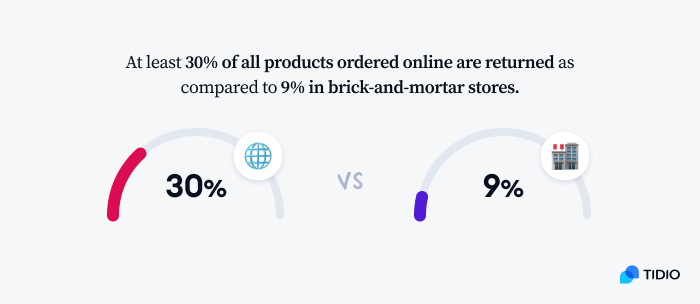
But why should you care about writing up a return policy for your online business anyways?
Why is ecommerce return policy important?
There are a number of reasons why your ecommerce store needs a return policy. The five most important points include that an ecommerce return policy:
- Gives customers a feeling of security
People expect it and want to have security on their purchase. In fact, 62% of consumers expect online stores to accept returns within 30-days of purchase. This will let them know that you stand by your product, and if anything is wrong, the shopper can easily get their money back or exchange the item. This will also improve the customer experience they have while shopping with you.
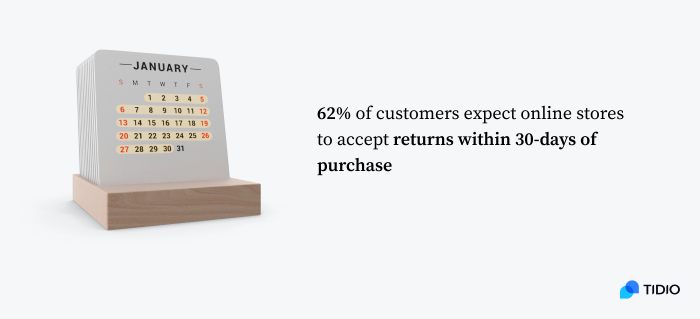
- Ensures you stay fair
Over 84% of online buyers would stop shopping with a retailer after a bad returns experience. So, ensure that doesn’t happen to your brand. Understand that online customers cannot touch or see your products in detail, therefore, they might not be satisfied with the items after it arrives. Give them a chance to return the item or exchange it, and you might gain a life-long customer in the process.

Read more: What Is Customer Loyalty? [Definition, Tips & Examples]
- Improves the trustworthiness of your brand
Our research found that about 34% of Gen Z shoppers don’t trust the majority of online stores. One way to increase your website is trustworthy is to offer a return policy and make it a great one.
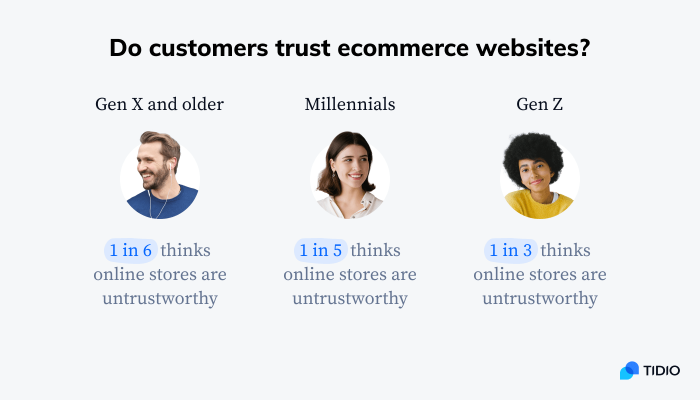
- Increases retention rates
Research shows that online returns are reaching 30% and about 92% of consumers say that they will buy again if the product return process is easy. It seems quite obvious that you should provide an easy return process then, doesn’t it?
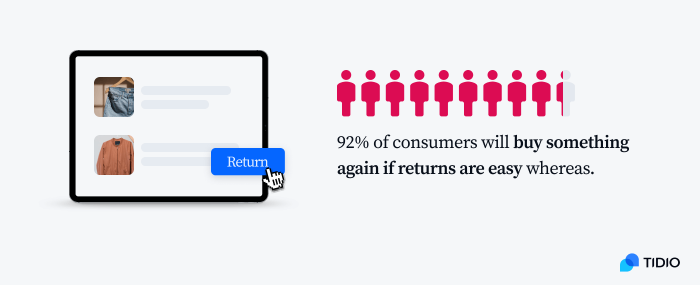
- Creates clarity between the seller and the buyer
Your customers know what to expect. An ecommerce refund policy ensures that your shoppers know exactly what they can return and in what time frame. They also know the conditions for refunds and exchanges. It saves you the trouble of informing every shopper individually of what you can do for them in case they’re not satisfied with the products.
Bottom line—
Clear return policy can help online retailers speed up the purchase decision of the potential customers. So it’s important to satisfy customer expectations and show that your company is customer-centric. Help customers remove the hassle of returning a product, and you will see repeat purchases from them in no time.
Since we know why you should have a return policy on your ecommerce website, let’s look at how to write a good one, shall we?
Read more: Learn about ecommerce return statistics and other relevant data.
Ecommerce returns: best practices
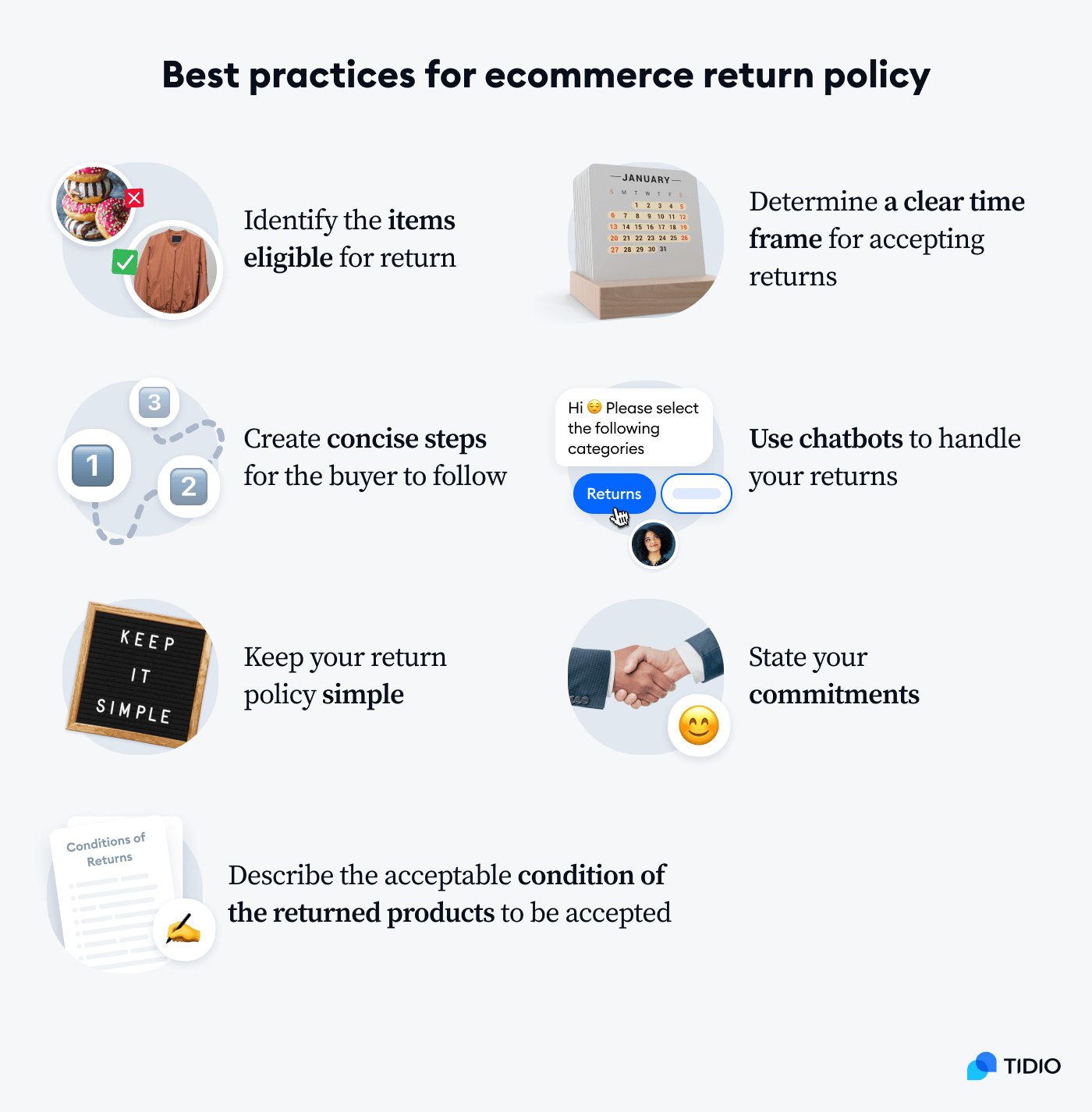
Just like your product pages should have a clear product description, your ecommerce return policy should also be clear. This can help you improve customer satisfaction and increase your sales in the long run.
Here are some of the best practices for writing an ecommerce return policy:
Identify the items eligible for return
Will all of your items be eligible for a return? Do you have any perishable products that will not be the same after the return? State clearly which of your merchandise can be returned for refund or exchange and which ones cannot.
Determine a clear timeframe for accepting returns
This return window can be anything between a week and a year, or even longer. It depends on what works best for your business and will satisfy your customers. The most typically used timeframe is 30 days, and this is what most customers expect. Also, make sure you state whether all the eligible products have the same timeframe for returns.
"In my opinion, it is critical to the success of your Return and Refund Policy that you make it crystal clear to your customers exactly how much time they have to return an item in order to receive a refund or exchange it for a different size or color."

Describe the acceptable condition of the returned products to be accepted
Make sure you state exactly how you expect the products to be returned to your store. List all your requirements, for example, the clothing to be unworn, in the original packaging, and with the original tags attached. Make sure you state that any returns that don’t satisfy your requirements will not be accepted.
Create concise steps for the buyer to follow
Give the buyer clear instructions to follow when they want to return one of the purchased items. You can make a self-return portal or ask them to contact you directly. List the steps from packing, through labeling, to shipping the items back to your store in the guide for the clients.
Use chatbots to handle your returns
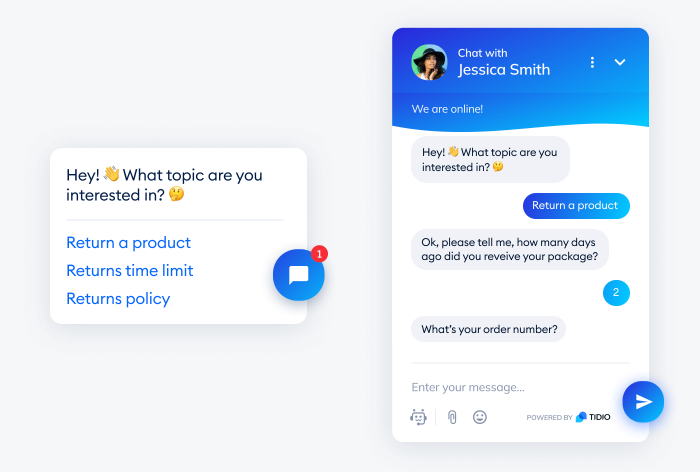
Chatbots are a great ecommerce returns software. You can add them to your site, and they will ask the shopper for all the details you need from them and walk them through the ecommerce returns process. This way, your customer is satisfied with the help they receive from your store, and you don’t have to spend your time on it.
Learn how to use AI technology and enhance your customer service
Learn how to create a FAQ chatbot for your customers’ queries with Tidio.
Keep your return policy simple
Use plain language and make the rules easy to understand. Don’t let your conditions be up for interpretation. State everything in your policy clearly and make sure your customers will understand what the rules for returns are and how to do it. Also, seek feedback from other people before publishing your online return policy to be on the safe side.
Make customers aware of your commitments
Make it clear whether you will cover the cost of return shipping and how long you need for processing returns. This means that you should mention in the policy if you provide a return shipping label or that they should get this on their own behalf. Also, ensure you have enough time to process customer returns and state when the client should expect their full refund.
These are some of the best practices you can use when writing up your online store policy. To gain inspiration, let’s have a look at a sample return policy for ecommerce shopping.
Ecommerce return policy template
Having an online store return policy can save you a lot of struggle in the future. But how to write it effectively? Even if you go through the steps above, you might still feel a little lost and don’t know where to start.
And staring with a blank document is the worst! So, let’s make it a little easier on you and go through some templates you can use when writing the return policy for your ecommerce store.
General ecommerce return policy for online stores

Because ecommerce stores face more returns than brick-and-mortar stores, you should pay more attention to writing the policy up. Make sure it’s specific to your products and set a good timeframe. Also, include all the items in your store that you do not wish for customers to be able to return. But you already know all that, so let’s now see an example you can use:
| If you are not satisfied with your purchase for any reason, you can return the product within 30 days of purchase. We will provide you with a return shipping label upon your return request. You can choose to exchange the product, return it for store credit, or get a refund to your original payment method. Please note that returned products must be unworn, in the original packaging, and with the original tags still attached. If the returned items do not satisfy these requirements, your return will not be eligible for a refund or exchange. Please note that there are exceptions to our return policy stated below: – Discounted items from a final sale cannot be returned for a refund nor exchanged – Perishable goods, for example, food and drinks, cannot be returned for a refund nor exchanged – Beauty products must be returned unused in the original packaging within 14 days of purchase To return a purchased item, follow the steps below: 1. Email us with your order number and state which items you would like to return. We will provide you with a free shipping label. 2. Make sure the items you’re returning do not have any visible signs of use and have the original tags on. 3. Package the products into their original packaging. 4. Put the products into shipment packaging and stick the provided return shipping label on it. 5. Bring your package to the post or order a free pick-up from your location. We will need 14 days to process your return and assess it for eligibility. After it has been accepted, we will send you an email and your refund should be in your account within 7 to 14 days depending on your bank. |
Return policy for small businesses

Returns are very difficult for a small business. When every purchase matters to you and every return is a cost to your store, you need to make sure your return policy is clear and precise. But also ensure that your clients are happy with it to the point of buying from you again. This will promote customer loyalty and increase your sales.
Let’s say you have a small store and an online shop for this return policy sample.
| You can return the product within 30 days of purchase if you are not satisfied with it. You can choose to ship it to us or bring it to the store. Items can be exchanged, returned for store credit, or refunded to the original payment method. Please note that there are exceptions to this return policy and they are: Items from our special collections must be returned within 14 days of purchase Discounted products cannot be returned for a refund nor exchanged All beauty products must be returned unused within 14 days of purchase All returned products must be unworn, in the original packaging, and with the original tags still attached. If the returned items do not satisfy these requirements, your return will not be accepted. Keep in mind that if you choose to return the items via post you will need to cover the shipping costs. You can return the products to the store at no cost. To return a purchased item, follow the steps below: 1. Send us an email with your order number and state which items you would like to return or come by the store with your receipt. 2. Ensure the items you’re returning have not been used, and they have the original tags attached. 3. Pack the products into their original packaging if they were in one. 4. If you’re shipping the items to us, put the products into shipment packaging and stick the purchased label on it. 5. Bring your package to the post or order a pick-up from your location. We commit to processing your return within 14 days of receiving the package. And you will get your refund after your returned products have been accepted within 5-10 business days depending on your bank. |
Online boutique return policy

If your ecommerce business is an online boutique then the majority of your stock is clothes. You might have some shoes and beauty products, as well as, jewelry or watches. Remember to ensure that your return policy applies to all types of products you’re selling at your online shop.
| [Company name] accepts returns of unworn products with the original tags attached. We offer free return shipping within 30 days of purchase. You can choose to exchange the product, return it for store credit, or get a refund to your original payment method. If the returned items have visible sign of wear or do not have tags attached, your return will not be eligible for a refund or exchange. Please note that there are exceptions to our return policy stated below: Discounted items cannot be returned for a refund nor exchanged Jewelry must be returned within 14 days of purchase Handmade items must be returned within 7 days of purchase To return a purchased item, follow the steps below: 1. Email us your order number and state which items you would like to return. 2. We will email you a return label back. 3. Make sure the items you’re returning do not have any visible signs of use and have the original tags on. 4. Package the products into their original packaging. 5. Put the products into shipment packaging and label it. 6. Bring your package to the post or order a free pick-up from your location. We will process your return within 10 days of receiving it and items will be assessed whether or not they are eligible for refund. If your return products are accepted, you will get the refund within 14 to 30 days of the return. |
Dropshipping return policy template

When you have a dropshipping business, you don’t physically have the products you’re selling. So, the return policy is at the discretion of the supplier. Ensure you look through your manufacturer’s website when writing up your policy and match the information to their statements.
As an example, let’s say you’re using AliExpress for your dropshipping business. This is a sample return policy in this case:
| If you are not satisfied with the product you bought, you can return it for a refund within 10 days from receiving the item(s). Please note that there are exceptions to our return policy stated below: Discounted items from a final sale cannot be returned for a refund nor exchanged Perishable goods, for example, food and drinks, cannot be returned for a refund nor exchanged If the item you purchased comes from an individual seller, check their return policy for details. If they don’t state any return information, then their products will come under this return policy. Please note that returned products must be unworn, in the original packaging, with the safety seals not damaged and the original labels retained. If the returned items do not satisfy these requirements, your return will not be eligible for a refund or exchange. To return a purchased item, follow the steps below: 1. Open a dispute with us within 10 days of receiving the order. We will provide you with a free return label. 2. Make sure the items you’re returning do not have any visible signs of use and have the original tags on. 3. Package the products into their original packaging. 4. Put the products into shipment packaging and label it. 5. Bring your package to the designated pick-up point. We commit to processing your return, assessing its eligibility, and sending a refund to your account within 30 days of receiving the returned products. |
Read more: Shopify Dropshipping: All You Must Know in 2023
So, these are samples you can use when composing your ecommerce return policy. But wouldn’t it be useful to see what a great policy looks like in real life first? Let’s dive into that.
Online stores with free returns
Some stores just do it right! A few examples of these ecommerce websites include:
How do these stores deal with returns? Let’s go a bit more in detail and discover these great return policy examples, shall we?
Zappos
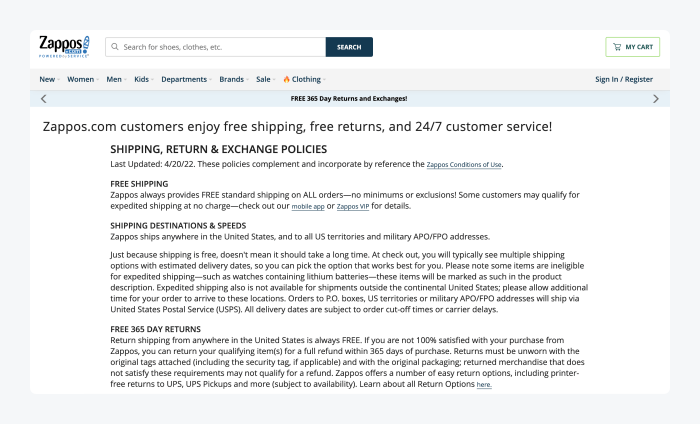
Zappos makes it easy for the shopper to return their merchandise and offers a very long return period of 365 days. Customers can return for a refund or exchange any purchased items they are not 100% satisfied with. These products must be unworn, have the original tag attached, and come with the original packaging. The refund typically takes between 5-10 days, and the exchanged items will be sent the next business day free of charge after the exchange process is completed.
Amazon
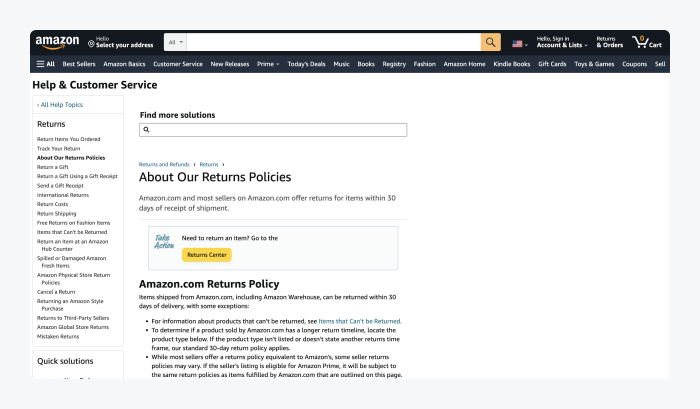
Amazon provides information for returns for each category of items sold by them. It also includes information about where to look to check if the return policy of the reseller on Amazon differs from the standard policy. Customers can return products for a refund within 30-days of delivery. The refund can take between two and 30 days. This depends on the customer’s preferred method for the refund.
Best Buy
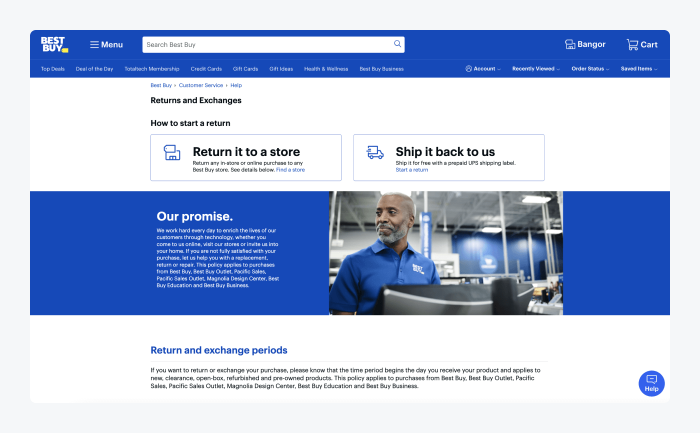
Best Buy offers two methods that clients can use to return the purchased items. Shoppers can either return the products to a store or use a pre-paid shipping label to post it back to the store. This company gives 15 days from the date of delivery for customers to return their purchased items. The refund may take up to 10 days. Best Buy also states that all final sale merchandise cannot be returned and some products, like activatable devices, have a restocking fee of $45 upon return.
Chewy
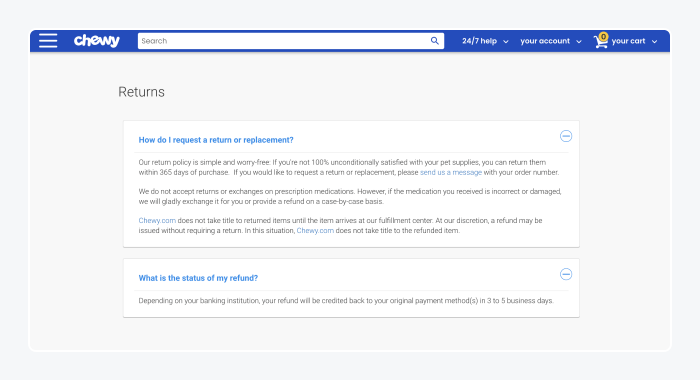
Chewy has a similar return policy to Zappos. It states that if the customer is not “100% unconditionally satisfied” with the supply, they can return the products within 365 days of purchase. All that the shoppers need to do is to send a message to the company with the order number and request a return or replacement. This company states that prescription medications are not subject to return or exchange.
Kohl’s
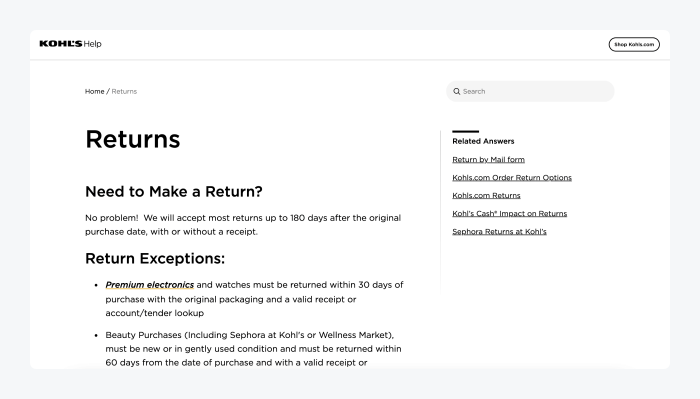
Kohl’s offers 180 days for customers to return their product with or without a receipt. They also clearly state the exceptions to this rule. This company states that premium electronics and watches as well as beauty products must be returned in a shorter period and with a valid receipt. They also inform shoppers that in-store purchases must be returned in-store, and it’s not possible to return these through shipping.
Key takeaway
An ecommerce return policy is a set of rules your store puts in place for returning the items bought at your store. It’s important to have one to build trust with your clients, create clarity between you and the buyer, and increase the retention rate.
The best online store return policies include:
- Items eligible for return
- A clear timeframe for accepting returns
- Acceptable condition of the returned products to be accepted
- Concise steps for the buyer to follow
Learn from the established stores and go through what they include in their return policy. Take an example and create your own policy that is tailored to your store and products. And always remember to keep it simple for the client to understand.
FAQ
Can an online store have a no return policy?
Yes, if your ecommerce operates in the US. Online stores can have a no return policy. But it needs to clearly indicate it on their website, and in some states, it is a requirement to also state a no return policy in the checkout points.
In most countries, it is also required by law to repair, refund or exchange any faulty products. Also, customers from the EU have the right to return their products within 14 days for a full refund. This applies to online shopping, purchases made on the phone and buying products from a door-to-door salesperson.
How do I write an awesome return policy for my ecommerce store?
To write a great ecommerce return policy, follow the steps below.
- Determine which items can be returned
- Set a timeframe for returns
- Outline the state of products eligible for return
- Give instructions for a customer to follow when returning an item
How do you calculate ecommerce return?
To calculate your ecommerce return rate, you need to divide the number of returned products by the total number of items sold. Then, multiply it by 100.
Is it illegal not to give a refund?
No, it is not illegal to not give a refund as long as you state in your policy that your store doesn’t do it. If you do not have a refund policy posted stating that your online store does not offer refunds, then a customer is entitled to a refund.
How do you write a return policy for a small business?
To write a good ecommerce return policy for a small business, follow the steps below.
- Be clear about which items are eligible for a return
- Decide on the timeframe for returns
- Determine the conditions of the items to be eligible for return
- Outline specific steps for a customer to follow when returning a product
What makes a good return policy?
A good return policy is concise and clear for the consumer. It provides a feeling of security and trustworthiness in your business. The best return policies have a long timeframe for returns and provide multiple options for shipping back online purchases.

